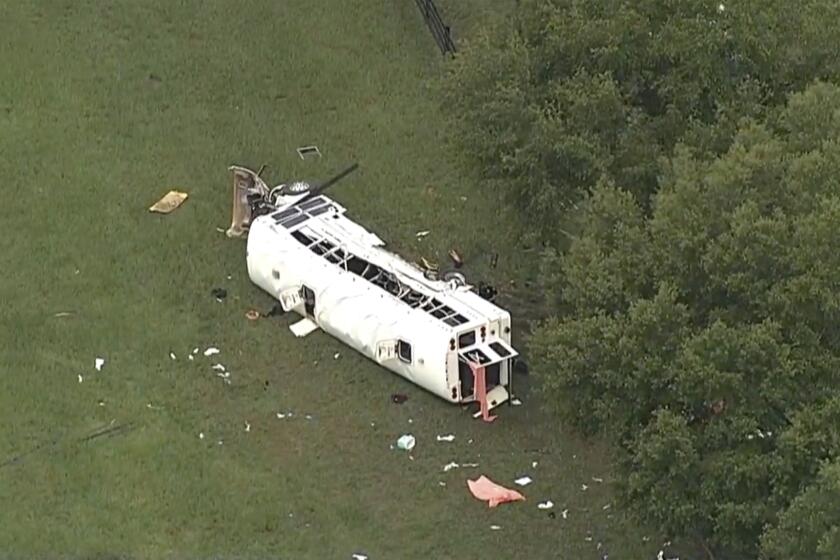In the Grip of a Wisp of Smoke
Claire Chasles doesn’t call it by its real name. She calls it “the monster.” On the day the monster came back, she ran up to her room, slammed the door and cried her eyes out.
And then she lit a cigarette.
The monster is lung cancer, caused by 2 1/2 decades of smoking that began when she was in high school.
She was 16 then and feeling immortal. Smoking was cool.
She is 42 now, and her cancer is advanced. Smoking is deadly.
And if her own ordeal weren’t frightening enough, she has another reason to be anxious: Her 21-year-old daughter, Christine Schulze, has smoked since ninth grade. Claire can’t get her to quit.
Christine wants to stop. But, like her mother, she can’t, even though she plans to marry in the fall and recently found out that she is pregnant.
“I have to do it now. I have to,” she says. “Now it’s not just me anymore.”
And then she lights a cigarette.
*
Claire and Christine are not alone. Between 40 million and 50 million Americans smoke. Most of them started as teenagers. Many of them learned it from their parents.
Watching mother and daughter through the coming months will offer a window into how one family copes with the consequences of smoking: how easy it is to start young and how hard it is to quit.
Countless studies have shown that nicotine is an addictive drug, that most smokers cannot stop any time they choose. Tobacco industry executives’ testimony notwithstanding, numerous memos and other internal industry documents indicate that cigarette companies constantly seek new smokers, particularly young ones. Kids know Joe Camel as well as they know Mickey Mouse.
Indeed, after falling for several years, teenage smoking is on the upswing. Last year, 21.6% of high school seniors used tobacco daily, up from 18.5% in 1991, according to the federal Centers for Disease Control and Prevention.
Cigarette smoking causes 87% of lung cancer cases, according to the American Cancer Society. This year the disease will claim an estimated 158,700 lives in the United States. The statistics are compelling. But they don’t tell the whole story.
They don’t tell of the crushing fatigue and shortness of breath that turn climbing a flight of steps into a major exertion. Or of trying to fall asleep with what feels like 10 tons of bricks across your chest.
They don’t describe the terror that comes with a telephone call from a doctor who tries to explain the meaning of the shadow on an X-ray. And they don’t tell of the guilt and self-recrimination that follow.
“I could kick myself for not listening to my parents,” Claire says. “I was stupid. Had I listened, I wouldn’t be in this predicament.”
Although the tobacco industry insists that it opposes teenage smoking, it aims much of its advertising and promotions at young people. In 1992, the industry spent more than $5 billion promoting its products in America.
The Clinton administration has proposed a series of regulations to curb teens’ access to cigarettes and to tobacco advertising.
Claire approves. “It would have stopped me. It was so easy back then. I used to buy them for my mom, at 10 cents a pack. I didn’t even have to have a note.”
*
It was almost as easy for Christine.
“Both my parents smoked,” she says. “One day I just picked it up and tried it, as an experiment. All my friends were smoking. The thrill of it was smoking in the bathroom and getting away with it.
“But then one day Mom saw the cigarettes in my pockets. I was 14 or 15. She didn’t like it, but I looked at her and said, ‘You’re doing it, and telling me not to? Yeah, right.’ ”
When Claire’s cancer was diagnosed two years ago, Christine cut her two-pack-a-day habit in half.
“But I just couldn’t quit. I tried. I really tried. But I was a real bitch. I felt like I was going nuts.”
Christine made a New Year’s resolution this year to quit. It lasted all of three days.
“I was doing good,” she says. “But then my fiance picked up some cigarettes, and I said, ‘That’s it. I can’t do it.’ I thought about trying the patch, but the doctor wouldn’t give it to me. He said I was too young and could [stop smoking] on my own. Maybe I’ll try being hypnotized. . . .”
She insists that it is not too late for her mother, or for herself.
“I suppose it could hit me,” she says, looking at her mother. “I don’t want to go through what you’re going through. By the time I’m your age, hopefully I will have quit by then.”
Christine and her mother are very close. In some ways they are more like sisters. They even look alike, with Christine a thinner version of Claire. Both have shoulder-length dark brown hair and animated personalities. Sometimes they giggle together like teenagers.
Until recently, Claire didn’t look sick enough to scare her daughter into giving up her cigarettes. In fact, she appeared quite robust. The only hint of serious illness was her husky voice, punctuated by occasional spasms of coughing.
She initially considered undergoing chemotherapy for her daughter’s benefit, thinking that a jolt of reality might drive her to give up cigarettes. She even picked out a wig.
“I thought if Christine saw me vomiting and losing my hair, she’d stop smoking,” Claire says. “She’s still basically a teenager who doesn’t think all that far ahead.”
Turning to her daughter, she asks: “It doesn’t scare you yet, does it?”
Christine mashes out her now-finished cigarette and shakes her head.
“No, not really,” she replies. “Not yet.”
The seriousness of her mother’s medical situation may have finally hit home last week. Claire’s lungs began to fill with fluid, and she required emergency surgery to drain them and to reinflate a collapsed lung. Christine could not stop weeping when describing her mother’s new crisis.
Claire should be home this weekend. But she and Christine may have to forgo a planned yard sale outing to hunt for bargains in baby things.
*
Before she became ill, Claire’s was a comfortable, satisfying life. She worked at the University of Maryland as an accounting clerk and took classes there at night. She had finished three years of college, majoring in French. In her spare time, she indulged in a passion for sewing and made all her own clothes.
Born Claire Bernard in Philadelphia, she grew up in Maryland, not far from where she lives now. Her father ran a dry-wall construction company, and her mother worked for many years as a waitress at a Howard Johnson’s. Her parents, who are French-Canadian, returned to their hometown in Quebec 18 years ago and opened a restaurant. They are retired.
Claire chuckles at her bilingual childhood. “When they nagged me about smoking, they yelled at me in French and in English.”
Now she lives in an upper-middle-class neighborhood in Bowie, about 35 miles outside Washington, in a comfortable two-story townhouse around the corner from a large shopping center.
Twice divorced, she shares the house with her fiance, John Joseph “Joe” Kelly, an electronic technician at the University of Maryland, his 12-year-old daughter, Jessica, and two Maltese dogs.
Christine and her fiance moved in last month so she could be close to Claire. Christine, a part-time waitress, was studying at the University of Maryland to become a physical therapist. But she dropped her college classes because, with her mother no longer working there, she would have to pay tuition.
Perhaps Christine’s most distinguishing features are her tattoos. “I’ve got a little bird on my right ankle, and a big parrot on my left thigh, and a tiger on my right shoulder blade. I like them.”
The townhouse is permeated by the odor of tobacco. Ashtrays are everywhere. Before the cancer, Claire would go through a pack or two daily. There would be several packs on the dining room table, especially when she was studying for finals or doing homework.
“I’d light ‘em up, and there’d always be one burning in the ashtray,” she says.
Joe smokes. Of course, Christine does. So does her boyfriend, Brady Green. Claire’s two former husbands smoked. Her 66-year-old mother still smokes. Her 39-year-old sister smoked for years. She quit once through hypnosis, then started again. After Claire’s diagnosis, she got scared and had herself re-hypnotized.
The family worries that Joe’s daughter, Jessica, will be next.
Claire has offered to be Jessica’s guinea pig if Jessica would do her science project on lung cancer. Claire will blow into a spirometer, which measures lung capacity, and Jessica will compare Claire’s results with those of a smoker, a former smoker and a nonsmoker.
Claire hopes they will be so dramatic that Jessica will be turned off by the idea of ever trying to smoke.
“She sees what I’m going through,” Claire says. “And she sees her father already addicted. In a way, all of this affects her more than it does Christine. Jessie’s just a little girl. She thought I was going to die. There is that chance. But I’m not going to tell her that.”
*
Claire’s ordeal started in October 1993 with a case of bronchitis. At least, that’s what everyone thought it was.
“It was bad enough for me to go to bed for a week,” she says. “At first I thought it was a cold. I had this harsh, harsh cough. They didn’t do a chest X-ray. I got better.”
It came back that December and the following March. Finally, she went to a doctor who ordered a chest X-ray.
Lung cancer seemed a remote threat; it rarely strikes people in their 40s. But as the X-ray indicated and a CT scan and a biopsy confirmed, it had struck Claire.
“I didn’t think it was all that serious the first time around,” she says. A surgeon removed 20% of the upper part of the cancerous lobe in her lung. While still in the hospital, she threw away her cigarettes.
Some evidence of cancer was found in a nearby lymph node but not in the “distant” nodes, such as those under the armpits--a good sign. After the operation, she had 5 1/2 weeks of radiation treatment to try to kill any residual cancer.
Six months after the operation, everything still looked great. At one year, it was the same. She was starting to relax.
Then, last October, 18 months after she was first diagnosed, another spot showed up on the same lung and in an armpit node.
“I got the call at work, in my office, and I hung up the phone and the girls were all looking at me, and the tears just started all over again,” she recalls. “It was worse for me this time, because I felt like I’d done everything I was supposed to. I had the surgery, I had the radiation, I’d quit smoking.”
She met Joe at a bar and broke the news.
“I hope you’re ready to deal with this monster again,” she told him. Then she declared: “I want a stiff drink. And when I get home, I want a cigarette.”
She still smokes an occasional cigarette, but she enjoys it less. It hurts. When she inhales, the back of her throat burns, and the base of her windpipe--where there is scar tissue from surgery--feels raw. It’s hard to breathe, and surgery has reduced her lung capacity.
“I’d love to sit back, watch TV with a glass of soda and a cigarette,” she says. “But I can’t. I cough all day long as it is, without the cigarettes.”
She pauses. “It’s addictive, it really is. No matter how much you try to stop, there’s this something on the back of your tongue that says: ‘Hey, it’s time for it.’ ”
Claire is being treated at Georgetown University’s Lombardi Cancer Center. For several weeks, she had participated in a clinical trial of an experimental drug, hoping against hope that it would work.
But after her lungs were drained, her doctors realized that her tumor was progressing, a process that likely had begun before she started taking the drug.
Now she probably will opt to try chemotherapy to extend her life as long as possible.
Although Claire’s cancer is considered to be advanced, CT scans of her abdomen, head and bones have been negative, although new scans probably will be done soon. So far, there is no evidence the cancer has spread, although microscopic cancer cells would not yet be detected.
For her stage and cancer type, Claire’s chances for long-term survival are poor. But she is optimistic.
In her battle against cancer, Claire has a few things going for her. One is Christine, who is about to quit her waitressing job so she can spend more time with her mother.
Another is her attitude.
“Dr. Rizvi told me my condition was more grave this time, but he doesn’t know me too well,” Claire says. “Maybe I’m just fooling myself, I don’t know. I don’t care what they tell me. I’m going to beat this thing. I don’t plan to die.”
More to Read
Start your day right
Sign up for Essential California for news, features and recommendations from the L.A. Times and beyond in your inbox six days a week.
You may occasionally receive promotional content from the Los Angeles Times.





